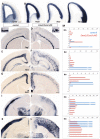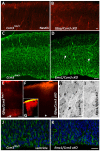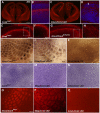Ccm3, a gene associated with cerebral cavernous malformations, is required for neuronal migration
- PMID: 24595293
- PMCID: PMC3943187
- DOI: 10.1242/dev.093526
Ccm3, a gene associated with cerebral cavernous malformations, is required for neuronal migration
Abstract
Loss of function of cerebral cavernous malformation 3 (CCM3) results in an autosomal dominant cerebrovascular disorder. Here, we uncover a developmental role for CCM3 in regulating neuronal migration in the neocortex. Using cell type-specific gene inactivation in mice, we show that CCM3 has both cell autonomous and cell non-autonomous functions in neural progenitors and is specifically required in radial glia and newly born pyramidal neurons migrating through the subventricular zone, but not in those migrating through the cortical plate. Loss of CCM3 function leads to RhoA activation, alterations in the actin and microtubule cytoskeleton affecting neuronal morphology, and abnormalities in laminar positioning of primarily late-born neurons, indicating CCM3 involvement in radial glia-dependent locomotion and possible interaction with the Cdk5/RhoA pathway. Thus, we identify a novel cytoplasmic regulator of neuronal migration and demonstrate that its inactivation in radial glia progenitors and nascent neurons produces severe malformations of cortical development.
Keywords: CCM3 (PDCD10); Cell autonomous function; Mouse; Nascent neurons; Neocortex; Radial glia.
Figures








Similar articles
-
Cdk5-dependent Mst3 phosphorylation and activity regulate neuronal migration through RhoA inhibition.J Neurosci. 2014 May 28;34(22):7425-36. doi: 10.1523/JNEUROSCI.5449-13.2014. J Neurosci. 2014. PMID: 24872548 Free PMC article.
-
Loss of cerebral cavernous malformation 3 (Ccm3) in neuroglia leads to CCM and vascular pathology.Proc Natl Acad Sci U S A. 2011 Mar 1;108(9):3737-42. doi: 10.1073/pnas.1012617108. Epub 2011 Feb 14. Proc Natl Acad Sci U S A. 2011. PMID: 21321212 Free PMC article.
-
Transcriptome clarifies mechanisms of lesion genesis versus progression in models of Ccm3 cerebral cavernous malformations.Acta Neuropathol Commun. 2019 Aug 19;7(1):132. doi: 10.1186/s40478-019-0789-0. Acta Neuropathol Commun. 2019. PMID: 31426861 Free PMC article.
-
CCM3 and cerebral cavernous malformation disease.Stroke Vasc Neurol. 2019 Mar 2;4(2):67-70. doi: 10.1136/svn-2018-000195. eCollection 2019 Jul. Stroke Vasc Neurol. 2019. PMID: 31338212 Free PMC article. Review.
-
Cerebral cavernous malformation proteins at a glance.J Cell Sci. 2014 Feb 15;127(Pt 4):701-7. doi: 10.1242/jcs.138388. Epub 2014 Jan 30. J Cell Sci. 2014. PMID: 24481819 Free PMC article. Review.
Cited by
-
Programmed Cell Death 10 Mediated CXCL2-CXCR2 Signaling in Regulating Tumor-Associated Microglia/Macrophages Recruitment in Glioblastoma.Front Immunol. 2021 May 24;12:637053. doi: 10.3389/fimmu.2021.637053. eCollection 2021. Front Immunol. 2021. PMID: 34108959 Free PMC article.
-
Effects of programmed cell death protein 10 on fecundity in Schistosoma japonicum.Parasitol Res. 2020 Apr;119(4):1317-1325. doi: 10.1007/s00436-020-06635-1. Epub 2020 Mar 9. Parasitol Res. 2020. PMID: 32152713
-
The multifaceted PDCD10/CCM3 gene.Genes Dis. 2020 Dec 30;8(6):798-813. doi: 10.1016/j.gendis.2020.12.008. eCollection 2021 Nov. Genes Dis. 2020. PMID: 34522709 Free PMC article. Review.
-
Ethanol-Induced Alterations in Placental and Fetal Cerebrocortical Annexin-A4 and Cerebral Cavernous Malformation Protein 3 Are Associated With Reductions in Fetal Cortical VEGF Receptor Binding and Microvascular Density.Front Neurosci. 2020 Jun 3;14:519. doi: 10.3389/fnins.2020.00519. eCollection 2020. Front Neurosci. 2020. PMID: 32655346 Free PMC article.
-
The Dual Role of PDCD10 in Cancers: A Promising Therapeutic Target.Cancers (Basel). 2022 Dec 3;14(23):5986. doi: 10.3390/cancers14235986. Cancers (Basel). 2022. PMID: 36497468 Free PMC article. Review.
References
-
- Alcamo E. A., Chirivella L., Dautzenberg M., Dobreva G., Fariñas I., Grosschedl R., McConnell S. K. (2008). Satb2 regulates callosal projection neuron identity in the developing cerebral cortex. Neuron 57, 364–377 - PubMed
-
- Angevine J. B., Jr, Sidman R. L. (1961). Autoradiographic study of cell migration during histogenesis of cerebral cortex in the mouse. Nature 192, 766–768 - PubMed
-
- Arlotta P., Molyneaux B. J., Chen J., Inoue J., Kominami R., Macklis J. D. (2005). Neuronal subtype-specific genes that control corticospinal motor neuron development in vivo. Neuron 45, 207–221 - PubMed
Publication types
MeSH terms
Substances
Grants and funding
LinkOut - more resources
Full Text Sources
Other Literature Sources
Molecular Biology Databases

